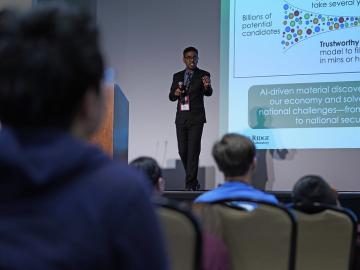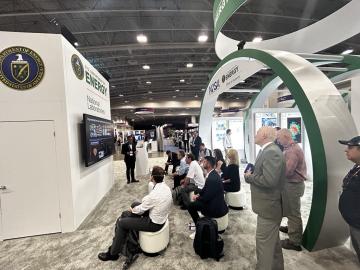
Filter News
Area of Research
- Advanced Manufacturing (1)
- Biology and Environment (25)
- Building Technologies (3)
- Clean Energy (96)
- Computational Biology (1)
- Computational Engineering (1)
- Computer Science (6)
- Fusion and Fission (4)
- Isotopes (3)
- Materials (45)
- Materials for Computing (12)
- National Security (15)
- Neutron Science (16)
- Nuclear Science and Technology (4)
- Quantum information Science (2)
- Supercomputing (51)
- Transportation Systems (2)
News Type
News Topics
- (-) Artificial Intelligence (62)
- (-) Big Data (46)
- (-) Buildings (43)
- (-) Coronavirus (29)
- (-) Microscopy (34)
- (-) Nanotechnology (32)
- (-) Polymers (20)
- (-) Security (13)
- (-) Space Exploration (22)
- (-) Transportation (67)
- 3-D Printing/Advanced Manufacturing (76)
- Advanced Reactors (22)
- Bioenergy (68)
- Biology (79)
- Biomedical (41)
- Biotechnology (15)
- Chemical Sciences (37)
- Clean Water (28)
- Climate Change (76)
- Composites (18)
- Computer Science (131)
- Critical Materials (16)
- Cybersecurity (17)
- Decarbonization (59)
- Education (1)
- Emergency (2)
- Energy Storage (66)
- Environment (153)
- Exascale Computing (27)
- Fossil Energy (5)
- Frontier (26)
- Fusion (42)
- Grid (48)
- High-Performance Computing (55)
- Hydropower (11)
- Irradiation (2)
- Isotopes (33)
- ITER (5)
- Machine Learning (34)
- Materials (79)
- Materials Science (88)
- Mathematics (9)
- Mercury (10)
- Microelectronics (2)
- Molten Salt (6)
- National Security (45)
- Net Zero (10)
- Neutron Science (77)
- Nuclear Energy (79)
- Partnerships (19)
- Physics (38)
- Quantum Computing (25)
- Quantum Science (41)
- Renewable Energy (1)
- Simulation (39)
- Software (1)
- Statistics (2)
- Summit (36)
- Sustainable Energy (95)
- Transformational Challenge Reactor (3)
Media Contacts

Two ORNL teams recently completed Cohort 18 of Energy I-Corps, an immersive two-month training program where the scientists define their technology’s value propositions, conduct stakeholder discovery interviews and develop viable market pathways.

Power companies and electric grid developers turn to simulation tools as they attempt to understand how modern equipment will be affected by rapidly unfolding events in a complex grid.

Researchers at the Department of Energy’s Oak Ridge National Laboratory and partner institutions have launched a project to develop an innovative suite of tools that will employ machine learning algorithms for more effective cybersecurity analysis of the U.S. power grid.

Researchers at Oak Ridge National Laboratory have opened a new virtual library where visitors can check out waveforms instead of books. So far, more than 350 users worldwide have utilized the library, which provides vital understanding of an increasingly complex grid.

In the wet, muddy places where America’s rivers and lands meet the sea, scientists from the Department of Energy’s Oak Ridge National Laboratory are unearthing clues to better understand how these vital landscapes are evolving under climate change.

Researchers at Oak Ridge National Laboratory have developed free data sets to estimate how much energy any building in the contiguous U.S. will use in 2100. These data sets provide planners a way to anticipate future energy needs as the climate changes.

Researchers at ORNL and the University of Maine have designed and 3D-printed a single-piece, recyclable natural-material floor panel tested to be strong enough to replace construction materials like steel.

Prasanna Balaprakash, a national leader in artificial intelligence, or AI, spoke to some of the highest achieving students in the country at the National Science Bowl in Washington D.C.

ORNL researchers and communications specialists took part in the inaugural AI Expo for National Competitiveness in Washington D.C, May 7 and 8, to showcase and provide insight into how the lab is leading the way for utilizing the vast possibilities of AI.

Oak Ridge National Laboratory scientists ingeniously created a sustainable, soft material by combining rubber with woody reinforcements and incorporating “smart” linkages between the components that unlock on demand.


